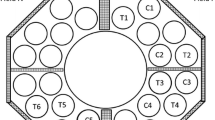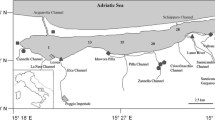Abstract
Vertical profiles of physical, chemical and phytoplanktonic parameters are described, at the level of the thermocline, in the area of Banyuls-sur-Mer, France. The results show that the thermocline divides two masses of water: (1) Mediterranean surface water with low nutrient concentrations and a salinity below 38.00 ‰; (2) deep, nutrient-rich upwelled water (N−NO3 >3 μat-g·l-1, P−PO4>0.3 μat-g·l-1, >38.30 ‰ S), which comes from the upper limit of the Mediterranean intermediate water, usually located at the 200 m level. Consequently, conditions are suitable for high production rates at the bottom of the thermocline, where Chl a is above 0.5 mg·m-3; dominant species are Nitzschia delicatissima and N. pungens. A diagram is presented explaining the different effects of the pycnoclines on primary production: eutrophication at the pycnocline levels is the result of passive accumulation of phytoplankton and organic matter during sedimentation, and/or of reduced diffusion of nutrients from deep waters towards the surface.
Résumé
-
1.
La thermocline s'établit fin juin dans la région de Banyuls, vers 30 m de profondeur. On observe, à son niveau, de forts gradients de salinité et de sels nutritifs.
-
2.
La discontinuité thermique sépare deux masses d'eau différentes: au dessus, l'eau superficielle méditerranéenne, épuisée en réserves nutritives, dont la salinité est voisine de 38,00‰, et en dessous, une eau dont la salinité dépasse parfois 38,30‰ et qui est riche en sels nutritifs: souvent plus de 3 μat-g N−NO3·l-1, et plus de 0,25 μat-g P−PO4·l-1.
-
3.
On observe, au tiers inférieur de la thermocline, un phytoplancton abondant: la teneur en chlorophylle a dépasse 0,5 μg·l-1, la production est proche de 10 mg C·m-3 (pour 6 h d'incubation à 12000 lux). Au-dessus de la thermocline, production et biomasse sont faibles: moins de 0,1 μg Chl a·l-1 et moins de 4 mg C·m-3. En dessous, la chlorophylle est toujours supérieure à 0,2 μg·l-1 et la production à 8 mg·m-3.
-
4.
La distribution des diatomées, groupe dominant, souligne moins nettement les effets de la thermocline. Les espèces principles sont: Nitzschia delicatissima, N. pungens et N. closterium.
-
5.
A Banyuls, la thermocline sépare deux écosystèmes: en surface, un écosystème mûr caractéristique d'eaux à faibles réserves nutritives, en profondeur, un écosystème jeune à forte production mais à rendement médiocre.
-
6.
L'eau située sous la thermocline a pour origine l'horizon supérieur de l'eau intermédiaire méditerranéenne située normalement vers 200 m. Cette eau est sous-saturée en oxygène: 4,30 ml·l-1.
-
7.
L'augmentation de la production au niveau des barrières de densité peut être due à trois modes d'action: accumulation passive de phytoplancton; minéralisation du matériel organique accumulé permettant une «regenerated production»; ralentissement de la diffusion, vers la surface, des sels nutritifs des eaux profondes, ce qui favorise la «new production».
-
8.
Pendant l'été 1970, à Banyuls, l'élévation de la production à la base de la thermocline correspond à la remontée de l'eau intermédiaire riche en sels nutritifs qui ne peuvent diffuser vers la surface en raison du gradient de densité. Ces conditions hydrologiques sont tout à fait inhabituelles.
Similar content being viewed by others
Littérature citée
Anderson, G. C.: Subsurface chlorophyll maximum in the North-east Pacific Ocean. Limnol. Oceanogr. 14 (3), 386–391 (1969).
Beers, J. R. and S. S. Herman: The ecology of inshore plankton populations in Bermuda. Part I. Seasonal variation in the hydrography and nutrient chemistry. Bull. mar. sci. 19 (2), 253–278 (1969).
Curl, H. Jr. and L. F. Small: Variations in photosynthetic assimilation ratios in natural, marine phytoplankton communities. Limnol. Oceanogr. 10 (Suppl.), 67–73 (1965).
Dugdale, R. C. and J. J. Goering: Uptake of new and regenerated forms of nitrogen in primary productivity. Limnol. Oceanogr. 12 (2), 196–206 (1967).
English, T. S.: Primary production in the central North Polar Sea drifting station alpha, 1957–1958. Proc. int. Oceanogr. Congr., N.-Y. 338–389 (1959).
Fedorov, V. D. and V. A. Semin: Primary production in relation to the hydrological regime of a sea basin (exemplified by the White sea). Oceanology 10 (2), 242–253 (1970).
Findenegg, I.: Produktionsbiologische Planktonuntersuchungen an Ostalpenseen. Int. Revue ges. Hydrobiol. 49 (3), 381–416 (1964).
Holmes, R. W.: Surface chlorophyll a, surface primary production and zooplankton volumes in the eastern Pacific Ocean. Rapp. P.-v. Réun. Cons. perm. int. Explor. Mer 144, 109–116 (1958).
Ichimura, S., S. Nagasawa and T. Tanaka: On the oxygen and chlorophyll maxima found in the metalimnion of a mesotrophic lake. Bot. Mag., Tokyo 81 (955), 1–10 (1968).
Jacques, G.: Aspects quantitatifs du phytoplancton de Banyuls-sur-Mer (Golfe du Lion). III. Diatomées et dinoflagellés de juin 1965 à juin 1968. Vie Milieu 20 (1-B), 91–126 (1969).
— Aspects quantitatifs du phytoplancton de Banyuls-sur-Mer (Golfe du Lion). IV. Biomasse et production 1965–1969. Vie Milieu 21 (1-B), 37–102 (1970).
—: Climat et hydrologie à Banyuls-sur-Mer (Golfe du Lion), 1965–1968. Vie Milieu 20 (2-B), 279–316 (1969).
Lausi, D.: Chlorophyll content observations of the near surface scattering layers in the Mediterranean sea. G. bot. ital. 102 (6), 529–535 (1968).
Lorenzen, C. J.: Vertical distribution of chlorophyll and phaeo-pigments: Baja California. Deep Sea Res. 14, 735–745 (1967a).
— Determination of chlorophyll and phaeo-pigments: spectrophotometric equations. Limnol. Oceanogr. 12 (1), 343–346 (1967b).
Margalef, R.: Corrélations entre certains caractères synthétiques des populations du phytoplancton. Hydrobiologia 18, 155–164 (1961).
Margalef, R, J. Herrera, M. Steyaert et J. Steyaert: Distribution et caractéristiques des communautés phytoplanctoniques dans le bassin tyrrhénien de la Méditerranée en fonction des facteurs ambiants et à la fin de la stratification estivale de l'année 1963. Bull. Inst. r. Sci. nat. Belg. 42 (5), 56 p. (1966).
Minas, H. J.: A propos d'une remontée d'eaux «profondes» dans les parages du Golfe de Marseille (octobre 1964). Conséquences biologiques. Cah. océanogr. 20 (8), 647–674 (1968).
— La distribution de l'oxygène en relation avec la production primaire en Méditerranée Nord-Occidentale. Mar. Biol. 7, 181–204 (1970).
— Résultats préliminaires de la campagne «Mediprod I» du Jean-Charcot (1–15 mars et 4–17 avril 1969). Investigación pesq. 35 (1), 137–146 (1971).
Morel, A.: Mise au point d'une méthode spectrophotométrique pour le dosage de l'oxygène dissous dans les eaux de mers. Bull. Inst. océanogr. Monaco 64, (1332) 31 p. (1965).
Steele, J. H. and I. E. Baird: Relation between primary production, chlorophyll and particulate carbon. Limnol. Oceanogr. 6 (1), 68–78 (1961).
— and C. S. Yentsch: The vertical distribution of chlorophyll. J. mar. biol. Ass. U.K. 39, 217–226 (1960).
Steemann-Nielsen, E. and V. K. Hansen: Light adaptation in marine phytoplanktonic populations and the interrelation with temperature. Physiologia Pl. 12 (2), 353–370 (1959).
Strickland, J. D. H. and T. R. Parsons: A practical handbook of seawater analysis. Bull. Fish. Res. Bd Can. 167, 1–311 (1968).
Unesco: Determination of photosynthetic pigments on seawater. Monogr. oceanogr. Meth. 1, 1–69 (1966).
Author information
Authors and Affiliations
Additional information
Communicated by J. M. Peres, Marseille
Rights and permissions
About this article
Cite this article
Cahet, G., Fiala, M., Jacques, G. et al. Production primaire au niveau de la thermocline en zone néritique de Méditerranée Nord-Occidentale. Mar. Biol. 14, 32–40 (1972). https://doi.org/10.1007/BF00365778
Accepted:
Issue Date:
DOI: https://doi.org/10.1007/BF00365778




